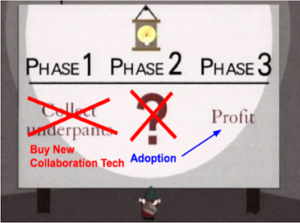Video collaboration assets are expensive and complex, but they can result in huge benefits if they are implemented correctly. Where companies have stumbled in the past is the implementation phase, or “Phase 2”. We have all heard many stories of organizations that bought a bunch of video collaboration technology in the past only to see adoption go up briefly and then plateau shortly thereafter with no real impact on the bottom line, leaving a lot of people wondering: “Who wrote the check?”
Talk to anyone who has been around video collaboration for a while though, and Phase 2 becomes pretty clear… Adoption. It is only when people actually use video that you realize the benefits in the form of increased productivity, lower costs, and yes, profit. That sounds really simple, but it is definitely more complex underneath. What is the right level of adoption? Who should adopt? How do we want them to use it? Which type of usage is most cost effective? Which type of usage has the biggest impact on our business?
3 Ways to Drive Video Adoption
There is a natural negative bias to new and potentially challenging technologies that has stopped people from using every major advance in history. It was only when people actually hopped in the “horseless carriage” that we saw explosive growth and benefits to society as a whole. Video collaboration is overcoming that same challenge now. To overcome that challenge, let’s look at some tactical solutions:
- Conduct training and education campaigns: Get people to use the tools by physically sitting them down and showing them how to do it. Time-consuming as it is, this method is how IT effectively got people to use new technologies back in the day. Try setting up multipoint video conferences to cut some of the time down and allow folks to practice hopping on and off of video calls with you, they’ll get the hang of it and love it.
- Force them to use it: Hold company-wide meetings or mandatory training over video to help your employees get used to it. Make it difficult to meet any other way that they have no real choice. This method may sound drastic, but it actually helps companies save money.
- Incentivize usage: The opposite of the stick is the carrot, and it is usually far more effective in the long run. It doesn’t always have to be monetary either; people like all kinds of incentives from goody bags to public praise and privileged status. Track top users and participants in your company and make it a point to applaud their success.
Tracking Adoption: Theory vs Practice
In reality, most companies implement some combination of all three tactics. Whatever you choose to do, the common task is that you need to measure how effective these activities are. In theory, measuring one metric like “adoption” is easy, but most organizations aren’t that simple: the Customer Support team operates differently than Engineering or Marketing, so you can’t have one metric for everyone. For example, customer support might use video for more 1:1 calls going outside of the organization while marketing may conduct more internal multi-party video meetings.
Frequently, there are also multiple technologies to monitor. Are you tracking video adoption alone, or tracking video, audio, AND web conferencing? Setting and measuring goals across multiple types of technology increases the complexity exponentially. Even if you just want to isolate and measure video, most video deployments these days aren’t just pieces of hardware. You need to monitor usage across software, desktop clients, hardware, and browser-based video. These layers of complexity can make it extremely tedious to collect, organize, clean and review the data (that’s assuming you can get to it easily).
Defining Success
In the end, adoption is definitely something you want to measure as a precursor to “success” with video deployments. Tracking adoption will definitely give you an early indicator of impacts on productivity and cost savings, but it is not as simple as it sounds. You need to harness the data generated by your new technology, and you need to make data analysis easy and accurate in order to do it well. What do you think about video adoption in your organization? Do you have any idea how much video collaboration you have in your team or how it relates to revenue or productivity?







